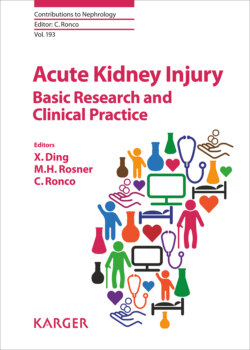Читать книгу Acute Kidney Injury - Basic Research and Clinical Practice - Группа авторов - Страница 38
На сайте Литреса книга снята с продажи.
SCr and Urine Output: The Problems
ОглавлениеBoth the urine output and the SCr have inherent flaws when applied to the acute situation. A fall in urine output may be either a normal physiological response to stressors or a pathological response to renal injury [16–18]. Where the urine volume is such that the normal solute load cannot be cleared, this will be reflected in classical changes in serum electrolytes, acid base parameters and traditional “markers” of renal function including SCr and urea. As such, urine output may be of limited sensitivity and specificity in defining AKI as is reflected in the poor performance of urinary biochemistry particularly in the intensive care unit (ICU) setting [19]. Moreover, the clinical response to isolated oliguria may result in unnecessary intervention such as inappropriate fluid therapy and therefore, the presence of oliguria should always be interpreted within the clinical context as a whole [20]. This is not to advocate ignoring the urine output: the transition from physiological to pathological oliguria is unlikely to be stepwise. Therefore, detection of renal dysfunction may be made earlier if oliguria is noted. For example, in a study on critically ill patients, the diagnosis of AKI based solely on the presence of oliguria found that approximately 50% of these patients proceeded to develop AKI based on SCr criteria 24 h later [21]. Similarly, in a mixed ICU cohort, 69% of oliguric patients subsequently developed creatinine criteria for AKI diagnosis [22]. These results imply that not all patients with oliguria develop changes in SCr and as such using urine output criteria will increase the number of patients classified as having AKI. Furthermore, in some cases, this may identify a different cohort of patients. What is clear is that where the AKI criteria are satisfied using both SCr and urine output, this portends a worse outcome [23].
The SCr and the derived glomerular filtration rate provide the mainstay for outpatient management of chronic kidney disease. Creatinine is neither reabsorbed nor metabolised by the kidney (although tubular secretion does occur) and is freely filtered across the glomerulus and as such serves as a marker of renal function. However, the use of the SCr as a marker for AKI is far from ideal. Although the formation of creatinine is relatively constant under most conditions outside the ICU, this is not the case in the critically ill or where there is considerable metabolic disturbance as is found in many causes of AKI. Changes in SCr may overestimate renal function as a result of secretion in the proximal tubule and increases can be seen following the administration of medications that inhibit tubular secretion despite no change in renal function. SCr metabolism may also be affected by conditions common to many ICU patients including sepsis that may reduce production rates considerably [24, 25]. In addition, creatinine is distributed in the total body water and may, therefore, be affected by variations in volume status although this is unlikely to be of any major practical significance [26]. Furthermore, in the critically ill, low SCr may be observed related to reduced muscle bulk, liver disease, poor nutritional status and also augmented renal clearance. Comparing creatinine measurements obtained from different laboratories may confound the diagnosis further. Perhaps the most important limitation regarding the SCr as a marker of AKI is the creatinine kinetics associated with acute dysfunction with 24–36 h needed to elapse after a definite renal insult before a rise in SCr is detectable in many cases [27, 28]. It follows that any attempts to either prevent AKI in patient populations or indeed identify patients at risk are thwarted by the fact that the variables used to define AKI, creatinine and urine output, are such imprecise tools. Hence, there has been much interest in the pursuit of a quantifiable indicator that will allow for the early detection of AKI. Understandably this has been earmarked as an area of considerable research interest driven, in part, by the clinical models of care based on other biomarkers with cardiac troponins being the best known examples.
